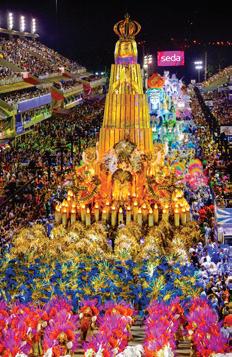
18 minute read
Beija-Flor
4ª colocada |
4th placed GRES Beija-Flor de Nilópolis
Advertisement
3ª Escola - Entre 23h30 e 23h50 3rd School - Between 11:30pm and 11:50pm Concentração | Meeting Point: Correios | Post Office
Sinopse do Enredo | Samba Theme Synopsis
A Beija-Flor de Nilópolis narra a evolução do homem e o seu caminhar (nas ruas) – desde os tempos mais primitivos –, a conquista de novos territórios e a criação das civilizações.
Beija-Flor de Nilópolis samba school narrates the evolution of mankind and his path (in the streets), starting from the most primitive times to the conquest of new territories and the creation of civilizations.
Cante com a Beija-Flor
Sing along with Beija-Flor
ENREDO: SE ESSA RUA FOSSE MINHA THEME: IF THIS STREET WERE MINE Compositores | Songwriters: Dario Jr., Diogo Rosa, Jean Costa, Júlio Assis, Junior Fionda, Magal Clareou e/and Thiago Soares. Intérprete | Singer: Neguinho da Beija-Flor
PRECEITO! MINHA FÉ PRA SEGUIR NESSA ESTRADA ODARA Ê! REINA FIRME NA ENCRUZILHADA ABRAM OS CAMINHOS DO MEU BEIJA-FLOR POR ROTAS JÁ TRILHADAS NO PASSADO O TEMPO DE TORMENTA QUE ESSE MAR LEVOU REVELAM ESTE NOVO ELDORADO NAS TRILHAS DA VIDA… DESBRAVADOR! DESTINO TRAÇADO… VENCEDOR! NOS BECOS DA SOLIDÃO MOLEQUE DE PÉ NO CHÃO
E NESSAS ANDANÇAS EU SIGO TEUS PASSOS SÃO TANTAS PROMESSAS DE UM PEREGRINO É CRER NO MILAGRE, SAGRADOS VALORES EM TANTOS ALTARES, EM TANTOS ANDORES
A VELA QUE ACENDE A DOR QUE SE APAGA A MÃO QUE AFAGA SE TORNA CORRENTE
NILOPOLITANO EM ROMARIA A FÉ ME GUIA! A FÉ ME GUIA!
EM MEUS DEVANEIOS ENTRE O REAL E A IMAGINAÇÃO SAUDADE PERSISTE, INSISTE EM PASSEAR NO CORAÇÃO FEITO UM POEMA A BEIRA-MAR CANTO PRA TE VER PASSAR ME VEJO EM TEU CAMINHO NESSA IMENSIDÃO AZUL DO TEU AMOR E ÀS VEZES, PERDIDO EU ME ENCONTRO EM TUAS ASAS, BEIJA-FLOR POR MAIS QUE EXISTAM BARREIRAS EU VIM PRA VENCER NO TEU NINHO É BOM LEMBRAR, EU NÃO ESTOU SOZINHO
LAROYÊ INA MOJUBÁ ADAKÊ EXU ÔÔÔ SEGURA O POVO, QUE O POVO É O DONO DA RUA Ô CORRE GIRA, QUE A RUA É DO BEIJA-FLOR
© Copyright: Editora Musical Escola de Samba Ltda.
Acompanhe o Desfi le | Parade Sequence
COMISSÃO DE FRENTE | HONORARY COMMITTEE FANTASIA: O DONO DA RUA COSTUME: THE OWNER OF THE STREETS COREÓGRAFO | CHOREOGRAPHER: MARCELO MISAILIDIS Realidade, fi cção, modernidade e ancestralidade misturam as culturas, afro-brasileira e do HipHop. A apresentação mostra gangues rivais disputando o domínio sobre as ruas. Nesse embate, chegam as Pombagiras, que trazem para esta dimensão a mensagem de Exu, o verdadeiro dono do lugar. | Reality, fi ction, modernity and ancestry mix Hip-Hop and Afro-Brazilian cultures. The presentation shows rival gangs vying for dominance over the streets. In this clash, AfroBrazilian spiritual entities (Pombagiras) get involved. They bring the message of Esu, who is, according to Afro-Brazilian religions, the actual owner of the place.
GRUPO: SENHOR DOS CAMINHOS GROUP: LORD OF THE PATHS A fantasia faz alusão a Exu, divindade concebida como sendo o senhor de todos os caminhos. The costume alludes to Esu, a deity conceived as the lord of all paths.
1º CASAL DE MESTRE-SALA E PORTA-BANDEIRA 1ST MASTER-OF-CEREMONIES-AND-FLAG
BEARER COUPLE: CLAUDINHO SOUZA E/AND SELMINHA SORRISO FANTASIA: O SOL –ILUMINADOR DOS CAMINHOS COSTUME: THE SUN – ILUMINATIOR OF PATHS Representa a estrela central do sistema solar: o sol, irradiando a luz que irá iluminar a nossa caminhada. | It represents the central star of the solar system: the sun, radiating the light that will illuminate our path.
1ª ALA: A ERA DO GELO - AS PRIMEIRAS JORNADAS 1ST WING: THE ICE-AGE - THE FIRST JOURNEYS Representa o homem de Cro-Magnon, pioneiros da Era do Gelo. | It represents the Cro-Magnon man, pioneers of the Ice Age.
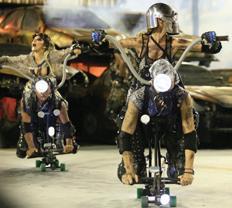
DESTAQUES DE CHÃO | FLOOR SPOT: THAÍS MÜLLER FANTASIA: GLACIARES COSTUME: GLACIERS Referência aos glaciares que usavam peles para revestir e aquecer seus corpos. | Reference to glaciers that used animal fur skins to coat and warm their bodies.
1º CARRO – ABRE-ALAS: O VOO DO BEIJA-FLOR GLACIAL | OPENING FLOAT: THE FLIGHT OF THE GLACIAL HUMMINGBIRD Com o aquecimento do globo, o homem de CroMagnon, que viveu a última era glacial, teve seus caminhos abertos e iluminados pelo sol. | As the globe got warmer, the Cro-Magnon man, who lived through the last Ice Age, had his paths open and lit by the sun.
2ª ALA: ANUNNAKI – DO CAMINHO DAS ESTRELAS AO ALVORECER DA CIVILIZAÇÃO 2ND WING: ANUNNAKY – FROM THE PATHS OF THE STAR TO THE DOWN OF CIVILIZATION É um grupo de divindades que percorre o caminho das estrelas. Vindos de Nibiru para explorar ouro, cruzaram o próprio DNA com o do homo erectus para que a humanidade fosse criada. | It is a group of deities that travels the path of the stars. Coming from Nibiru to explore gold, they crossed their own DNA with that of homo erectus so that humanity could be created.
3ª ALA: SUMÉRIOS – A INVENÇÃO DA RODA 3RD WING: SUMERIANS – THE INVENTION OF WHEEL Relembra os naturais da Suméria. A eles são atribuídas grandes invenções, como a roda. | It celebrates Sumerian natives. They are credited with great inventions, such as the wheel.
4ª ALA: ESTRADA REAL DA PÉRSIA – A ROTA DO ÂMBAR | 4TH WING: ROYAL ROAD OF PERSIA – AMBER ROAD A mais antiga estrada ligando as civilizações da Mesopotâmia e do Egito foi o primeiro grande sistema de rodovias que deu origem a outras rodovias, como a Rota do Âmbar. | The oldest road connecting the civilizations of Mesopotamia and Egypt was the fi rst major road system that gave rise to other highways, such as the Amber Route.
5ª ALA: ROTA DA SEDA | 5TH WING: SILK ROAD (BAIANAS | WHIRLING LADIES) Considerada a mais valiosa mercadoria da China, a seda gerou a famosa Rota da Seda - rota comercial que ligava a China à Anatólia e à Índia com fl uxo constante de comerciantes. Considered the most valuable product in China, silk generated the famous Silk Road - a commercial route that connected China to Anatolia and India with a constant fl ow of traders.
6ª ALA: ETRUSCOS – O VAI E VEM NAS ROTAS DE COMÉRCIO | 6TH WING: ETRUSCANS – THE FLOW ON TRADE ROUTES Representação dos piratas da Etrúria, península itálica, que explorava ricas minas de ferro, prata e cobre. | It represents the pirates of Etruria, an Italian peninsula, which exploited rich mines of iron, silver and copper.
7ª ALA: ROMANOS – A EXPANSÃO DE UM GRANDE IMPÉRIO | 7TH WING: ROMANS – THE EXPANSION OF A GREAT EMPIRE O Império romano é o ápice da engenharia rodoviária antiga. | The Roman empire is the culmination of ancient road engineering.
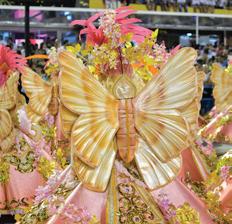
DESTAQUE DE CHÃO | FLOOR SPOT: SÁVIA DAVID FANTASIA: LÍBERA – A LIBERDADE DE IR E VIR COSTUME: LIBERA – THE FREEDOM TO COME AND GO Líbera, deusa da liberdade, representa o direito fundamental de locomação. Libera, goddess of freedom, represents the fundamental right of locomotion.
2º CARRO: TODOS OS CAMINHOS LEVAM À ROMA – “REGINA VIARUM” | 2ND FLOAT: ALL ROADS LEAD TO ROME – “REGINA VIARUM” Homenagem ao Império Romano, precursor na construção de grandes estradas. | Homage to the Roman Empire, precursor in the construction of great roads.
8ª ALA: NO CABO DAS TORMENTAS QUE O MAR LEVOU – CAMINHO MARÍTIMO PARA AS ÍNDIAS 8TH WING: CAPE OF GOOD HOPE OR CAPE OF STORMS – SEA ROUTE TO THE INDIES (BAIANINHAS | WHIRLING GIRL) Caminho percorrido por Vasco da Gama, de Lisboa a Calicute pelo Atlântico e contornando a África, para alcançar a Índia. | It is the sea route followed by Vasco da Gama, from Lisbon to Calicut, across the Atlantic and around Africa, to reach India.
9ª ALA: OS INCAS – CAMINHOS NO TOPO DOS ANDES | 9THWING: INCAS – THE PATHS ON THE TOP OF THE ANDES Os Incas construíram estradas do Equador ao Peru, incluindo a Rota dos Andes. O tráfego era feito com animais (lhamas) e pessoas a pé, pois não conheciam o uso da roda. | The Incas built roads from Ecuador to Peru, including the Andes Route. The traffi c was made with animals (llamas) and people on foot, as they did not know how to use the wheel.
10ª ALA: NATIVOS DE PINDORAMA 10TH WING: BRAZILIAN NATIVES As tribos de nativos do Brasil foram importantes demarcadores de caminhos por matas, campos, cerrados, e hidrovias naturais. The tribes of Brazilian natives were important to delimit paths through forests, fi elds, savannahs, and natural waterways.
11ª ALA: BANDEIRANTES – DESBRAVADORES A CAMINHO DO OURO 11TH WING: EXPLORERS – IN SEARCH OF GOLD Representa a busca por metais preciosos. O movimento das bandeiras era fortemente armado para prender e conduzir índios escravizados. | It represents the search for precious metals. The movement of explorers in Brazil was heavily armed to arrest and lead enslaved Indians.
DESTAQUE DE CHÃO | FLOOR SPOT: JOJO TODDYNHO FANTASIA: XICA, RAINHA DO TIJUCO COSTUME: XICA, THE QUEEN OF TIJUCO Francisca da Silva de Oliveira (Xica) foi uma escrava que viveu em Diamantina. Ela tornou-se concubina do contratador de diamantes, João Fernandes de Oliveira, com quem teve treze fi lhos. | Francisca da Silva de Oliveira (Xica) was a slave who lived in Diamantina. She became a concubine of the diamond contractor, João Fernandes de Oliveira, with whom she had thirteen children.
DESTAQUE DE CHÃO | FLOOR SPOT: THIAGO AVANCCI FANTASIA: CONTRATADOR DO ARRAIAL DO TIJUCO | COSTUME: DIAMOND CONTRACTOR FROM TIJUCO VILLAGE João Fernandes de Oliveira “marido” de Xica da Silva. | João Fernandes de Oliveira “husband” of Xica da Silva.
12ª ALA: NOBRES DO ARRAIAL DO TIJUCO 12TH WING: NOBLES FROM THE TIJUCO VILLAGE O Arraial do Tijuco teve a maior lavra de diamantes do mundo. | Arraial do Tijuco had the largest diamond mining in the world.
13ª ALA: PÉ-DE-MOLEQUE – PELAS RUAS DO RIO NO TEMPO DE DEBRET 13TH WING: COBBLESTONE STREETS – RIO DE JANEIRO IN DEBRET’S TIME As ruas da cidade do Rio no início do século XIX eram de calçamento conhecido como pedras de pé-de-moleque, com escravos descalços vendendo mercadorias vistos por Debret. | The streets of the city of Rio at the beginning of the 19th century were paved by cobblestones. Bare slaves used to sell goods as seen by the painter Debret. DESTAQUE DE CHÃO | FLOOR SPOT: CHARLENE FANTASIA: MUCAMA EM DIA DE FESTA COSTUME: A MAID ON A PARTY DAY No Rio pintado por Debret – artista francês de relevância e talento singulares no registro da História do Brasil – tem-se a graciosidade de uma mucama em dia de festa. | In Rio de Janeiro as painted by Debret – a French artist of singular relevance and talent in the record of the History of Brazil - there can be seen the grace of a maid on a feast day.
3º CARRO: NO RIO DO TEMPO DE DEBRET: AS RUAS DE PÉ-DE-MOLEQUE 3RD FLOAT: DEBRET’S TIME IN RIO: THE COBBLESTONE STREETS Retrata as ruas da cidade do Rio do século XIX, de calçamento de pedras chamadas pé-de-moleque. It portrays the streets of Rio de Janeiro in the 19th century, whose streets were paved with cobblestones.
14ª ALA: MECA – SEGUINDO OS PASSOS DO PROFETA | 14TH WING: MECCA – FOLLOWING THE STEPS OF THE PROPHET Peregrinação à Meca, “Hajj”, ritual espiritual à cidade e seus arredores, locais proibidos para os não muçulmanos, um dos pilares do Islã que todo fi el deve cumprir. | It represents the pilgrimage to Mecca, “Hajj”, a spiritual ritual made by Muslims only - one of the pillars of Islam that every believer must fulfi ll.
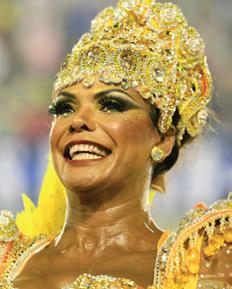

2º CASAL DE MESTRE-SALA E PORTABANDEIRA 2ND MASTER-OF –CEREMONIES
AND-FLAG-BEARER COUPLE: DAVID SABIÁ E/ AND FERNANDA LOVE FANTASIA: HINDUS COSTUME: HINDUS Seguidores do hinduísmo, a mais antiga “religião” do mundo. A ala retrata as peregrinações, ou viagens a locais sagrados, que são comuns no hinduísmo desde os tempos antigos. | Followers of Hinduism, the oldest “religion” in the world. The group depicts the pilgrimages, or trips to sacred sites, which have been common in Hinduism since ancient times.
3º CASAL DE MESTRE-SALA E PORTA-BANDEIRA 3RD MASTER-OF –CEREMONIES-AND
FLAG-BEARER COUPLE: MOSQUITO E/AND EMANUELLE MARTINS FANTASIA: HINDUS COSTUME: HINDUS IDEM. | IDEM.
4º CASAL DE MESTRE-SALA E PORTA
BANDEIRA | 4TH MASTER OF CEREMONIES AND FLAG BEARER COUPLE: JOSÉ ROBERTO E/AND NANINHA FIDELLYS FANTASIA: HINDUS COSTUME: HINDUS IDEM. | IDEM.
15ª ALA: BUDISMO – A ESCALADA AOS MONASTÉRIOS NO TOPO DO MUNDO 15TH WING: BUDDHISM – CLIMBING THE MONASTERIES ON THE THE TOP OF THE WORLD Representação do Budismo. It is a representation of Buddhism.
16ª ALA: JUDAÍSMO – PROFISSÃO DE FÉ NA CIDADE SANTA 16TH WING: JUDAISM – PROFESSION OF FAITH IN THE HOLY CITY O Judaísmo tem em Jerusalém uma das cidades sagradas. Um número grande de peregrinos judeus ruma para essa região. | Jerusalem is one of the holy cities of Judaism. A large number of Jewish pilgrims head to this area. RAINHA DA BATERIA| QUEEN OF PERCUSSION: RAÍSSA OLIVEIRA FANTASIA: LUA CIGANA COSTUME: GYPSY MOON O povo cigano preza por viver sob a luz da lua de prata que cintila no céu azul. | Gypsy people appreciate living under the light of the silver moon that sparkles in the blue sky.
17ª ALA: CIGANOS – A ESTRADA É MINHA PÁTRIA | 17TH WING: GYPSY – MY HOMELAND IS THE ROAD (BATERIA | PERCUSSION) MESTRE | BANDMASTER: PLÍNIO E/AND RODNEY Os ciganos são nômades, sem ligação histórica precisa a uma pátria defi nida ou a uma origem, daí viajarem em caravanas com acampamentos em tendas nas beiras das estradas. | Gypsies are nomads, with no precise historical connection to a defi ned homeland or origin, hence they travel in caravans with tented camps on the roadsides.
CARRO DE SOM | SOUND CAR INTÉRPRETE | SINGER: NEGUINHO DA BEIJA-FLOR
18ª ALA: LAVAGEM DO BONFIM 18TH WING: THE WASHING UP OF BONFIM CHURCH STAIRS (PASSISTAS | SAMBA DANCERS) A lavagem do Bonfi m é ritual de fi éis. Um cortejo de baianas e fi éis carregam água de cheiro, jarros de fl ores e vassouras. | The washing up of Bonfi m is a ritual for the believers. A procession of people from Bahia and the believers carry scented water, jars of fl owers and brooms.
19ª ALA: PEREGRINO NO CAMINHO DE SANTIAGO DE COMPOSTELA 19TH WING: THE PILGRIM ON THE WAY TO SANTIAGO DE COMPOSTELA Os Caminhos de Santiago na Espanha são o percurso dos peregrinos que afl uem para venerar as relíquias do apóstolo Santiago Maior. | The paths of Santiago in Spain are the ways followed by pilgrims who fl ock to venerate the relics of the apostle Santiago.
20ª ALA: PEÃO – ROMEIRO DE APARECIDA 20TH WING: COWBOYS – PILGRIMS OF APARECIDA Referência aos romeiros que acompanham a peregrinação à Nossa Senhora de Aparecida em São Paulo. | It is a reference to the pilgrims who accompany the pilgrimage to Nossa Senhora de Aparecida in São Paulo.
21ª ALA: PROCISSÃO - ANJO GUARDIÃO 21ST WING: PROCESSION - GUARDIAN ANGEL As fantasias representam um anjo, personagem sempre presente nas procissões. | The costumes represent an angel, a character who is always present in processions.
4º CARRO: SAGRADOS VALORES, EM TANTOS ALTARES E TANTOS ANDORES 4TH FLOAT: SACRED VALUES IN SO MANY ALTARS AND FEELINGS É a representação de um altar erguido em consagração à Virgem Maria em estilo barroco. It is the representation of an altar erected in consecration to the Virgin Mary in Baroque style.
22ª ALA: BROADWAY – A RUA DOS GRANDES MUSICAIS | 22ND WING: BROADWAY – THE STREET OF GREAT MUSICALS Homenagem à cidade de New York, EUA, conhecida pelos teatros que exibem superproduções de musicais. | Homage to the city of New York, USA, known for theaters that exhibit overproductions of musicals.
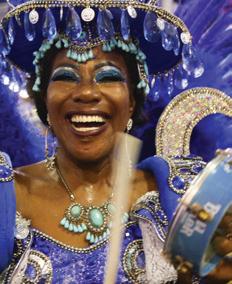
23ª ALA: CHAMPS-ÉLYSÉES – O CHARME E A MODA DE PARIS | 23RD WING: CHAMPS-ÉLYSÉES – THE CHARM AND THE FASHION OF PARIS Champs-Éysées é a prestigiada avenida de Paris, na França, cujo ícone é o Arco do Triunfo. | ChampsÉysées is the prestigious avenue of Paris, France, whose icon is the “Arc de Triomphe”.
24ª ALA: ABBEY ROAD – A ETERNA TRAVESSIA DOS BEATLES | 24TH WING: ABBEY ROAD – THE ETERNAL BEATLES’S STREET Representa a rua de Londres onde é situada a gravadora que ilustrou a capa do famoso álbum dos Beatles. | It represents the London street where is located the studio that illustrated the cover of the famous Beatles’ album.
25ª ALA: EL CAMINITO – ENTRE O PASSAR DOS ANDANTES, OS PASSOS DO TANGO DANÇANTE 25TH WING: EL CAMINITO – THE DANCING TANGO AMONG THE PEDESTRIANS Rua-museu localizada em La Boca, em Buenos Aires, Argentina. | Street-museum located in La Boca, Buenos Aires, Argentina.
26ª ALA: COPACABANA, PRINCESINHA DO MAR 26TH WING: COPACABANA, PRINCESS OF THE SEA Homenagem à canção “Copacabana”, bairro que possui a Avenida mais famosa do Brasil, a Atlântica. | Homage to the song “Copacabana”, a neighborhood that has the most famous avenue in Brazil: Atlântica.
DESTAQUE DE CHÃO | FLOOR SPOT: NICOLE BAHLS FANTASIA: NO AZUL DO MAR DE COPACABANA COSTUME: IN THE BLUE SEA OF COPACABANA A Avenida Atlântica tem um calçadão com mosaicos de pedras portuguesas nas cores preto e branco que emoldura a imensidão azul do mar. | Avenida Atlântica has a boardwalk with Portuguese stone mosaics in black and white that frames the blue immensity of the sea.
5º CARRO: COPACABANA – FEITO UM POEMA A BEIRA-MAR, CANTO PRA TE VER PASSAR 5TH FLOAT: COPACABANA – AS A POEM BY THE COAST, I SING TO SEE YOU PASS Faz homenagem a Copacabana, praia mais famosa do mundo. | It pays homage to Copacabana, the most famous beach in the world.
27ª ALA: VIA LÁCTEA – O CAMINHO DAS ESTRELAS | 27TH WING: MILKY WAY – THE PATH OF THE STARS Via celeste que só é possível percorrer em nossa imaginação. | Heavenly path that is only possible to pass through our imagination.
28ª ALA: TORRE DE BABEL – O CAMINHO QUE LEVAVA A DEUS | 28TH WING: BABEL TOWER – THE PATH LEADING TO GOD A história bíblica narra a tentativa dos humanos de construir em Shinar uma torre muito alta, um caminho que levasse aos céus, num tempo em que os homens falavam uma única língua. | The biblical story tells of the attempt by humans to build a very tall tower, a path that would lead to the heavens, at a time when men spoke a single language.
29ª ALA: LABIRINTO DO MINOTAURO – UM BECO SEM SAÍDA | 29TH WING: THE MINOTAUR’S MAZE –A DEAD-END ALLEY Mito grego em que uma criatura com cabeça e cauda de touro num corpo de homem habitava um labirinto na Ilha de Creta que era governada pelo rei Minos. It is a Greek myth in which a creature with a bull’s head and tail in a man’s body inhabited a maze on the island of Crete that was ruled by King Minos.
DESTAQUE DE CHÃO | FLOOR SPOT: YAGO MAPOUA FANTASIA: FADA DO ARCO-ÍRIS COSTUME: THE RAINBOW FAIRY
30ª ALA: GNOMOS – O OURO GUARDADO NO FINAL DO ARCO-ÍRIS | 30TH WING: THE TREASURE AT THE END OF THE RAINBOW Alusão ao gnomo que seria guardião do pote de ouro existente no fi nal do arco-íris. | It is an allusion to the gnome who would guard the pot of gold located at the end of the rainbow.
31ª ALA: ONTEM, HOJE, SEMPRE BEIJA-FLOR 31ST WING: YESTERDAY & TODAY - ALWAYS BEIJA-FLOR Beija-Flor: o pássaro é o símbolo da Agremiação de Nilópolis. | The hummingbird is the symbol of the Beija-Flor Samba School. 32ª ALA: COM PEDRINHAS DE BRILHANTES PARA A BEIJA-FLOR PASSAR | 30ND WING: PEBBLES OF BRILLIANTS TO BEIJA-FLOR WALK ON Retrata uma joia esculpida em diamantes como referência a como a escola é vista e tratada pela comunidade do entorno. | It portrays a jewel carved in diamonds as a reference to how the school is seen and treated by the surrounding community. The title makes reference to a famous lullaby song in Brazil.
DESTAQUE DE CHÃO | FLOOR SPOT: SÔNIA CAPETA FANTASIA: MARAVILHOSA E SOBERANA BEIJAFLOR | COSTUME: WONDERFUL AND SOVEREIGN BEIJA-FLOR As pedrinhas, os componentes da escola, os verdadeiros diamantes. | The pebbles, participants the school, are the true diamonds.
6º CARRO: NAS ASAS DO BEIJA-FLOR, O VOO MÁGICO NA RUA DO MARQUÊS | 6TH FLOAT: IN THE HUMMINGBIRD WINGS, THE MAGICAL FLIGHT OVER THE AVENUE OF THE CARNIVAL Faz menção à rua Marques de Sapucaí, visão poética, que retrata a Praça da Apoteose como um grande ninho de diamantes. | It mentions Marques de Sapucaí Avenue in a poetic vision, which depicts Praça da Apoteose (the end of the avenue) as a large diamond nest. VELHA-GUARDA: TESOURO NIPOLITANO HONORARY SENIOR MEMBERS: THE TREASURE OF NILOPOLIS
33ª ALA: NUM FESTIVAL DE PRATA EM PLENA PISTA, O POVO É O DONO DA RUA | 30RD WING: A FESTIVAL OF SILVER ON THE VERY AVENUE THAT BELONGS TO PEOPLE Grande ato coletivo humano que presta uma homenagem aos que vivem na rua, e que, na magia do carnaval, se transformam com brilho reluzente. Great collective human act that pays homage to those who live on the streets, but who are transformed with the shining brightness of Carnival.




Mocidade




Ficha Técnica | Technical Summary
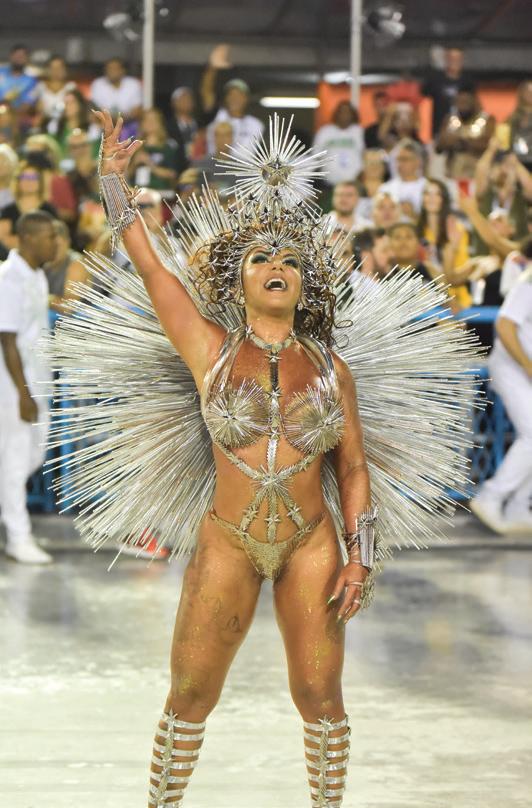
Enredo | Theme: ELZA DEUSA SOARES | ELZA GODDESS SOARES Fundação - 10 de novembro de 1955 | Established in November 10th, 1955 Presidente | President - Wandyr Trindade (Seu Macumba) Cores - Verde e Branco | Colors - Green and White Carnavalesco | Carnival Designer - Jack Vasconcelos Diretor de Carnaval | Carnival Director - Marco Antônio Marino Diretores de Harmonia | Harmony Directors - Wallace Capoeira






